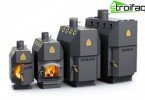Garage heating: autonomous, water, electric
Garage – a technical room and is mainly intended for storage and maintenance of a car. Why do you need garage heating? Firstly, in an unheated garage in the cold season, moisture accumulates that is brought on the car body and wheels, especially a lot of it gets into the garage with snow and ice frozen on the bottom. In a well-heated garage with good ventilation, the moisture brought in from the street does not last long, thanks to this the car body does not corrode. Secondly, in a heated garage engine starting is much easier, which significantly extends the battery life, reduces wear on the starter and the engine as a whole. Thirdly, in a warm room it is much easier to repair the car.
Content
- Combined or separate system?
- Garage Heating Methods
- Water type heat supply
- Solid fuel options
- Electric garage heating
- Garage gas heating
- How to heat with used oil
- The use of portable devices
Combined or separate system?
With the fact that the heating in the garage is absolutely necessary, we have decided now the turn for the implementation of the idea. There are more questions than answers as always. Is it possible to implement do-it-yourself garage heating or will you need specialist help? What is the best heating for the garage, as this or that heating system will show itself in operation, will it be practical? – Indeed, a heating device will require serious financial costs, both for the heating system itself and for fuel for it. To answer numerous questions, we consider in more detail all possible options for a heating device in a garage.
It is most advantageous to heat the garage built into the house or attached to it, for this the central water heating system of the house is used. If the garage is a separate building, then it is advisable to heat it with a home heating system when removing no more than 40 m, an additional water pump will be needed to circulate the coolant. At the same time, a serious attitude to the thermal insulation of the garage and the underground pipelines laid to it is important. The capacity of the boiler must be correctly calculated, taking into account additional energy costs.
The use of this type of heating is convenient from the point of view of safety and energy saving. With a large distance, heat losses increase greatly, the installation of a common heating system is not economically profitable, autonomous garage heating will be much more efficient.
Garage Heating Methods
- Water heating.
- Wood heating.
- Electric heating.
- Gas heating.
- Waste oil heating.
- Heating by portable heaters.
Water type heat supply
The safest and most convenient is heating the garage with hot water, which flows through the metal radiators. Water is heated in a boiler installed in another room. This method of heating the garage is possible provided that the garage is built into the house, is part of the house or is in close proximity to the house.
In this way, several garages located nearby can be heated, for example, in a garage or at enterprises. This heating system should work around the clock, when it is turned off, the water will freeze, which will render the system unusable. If only periodic heating of the garage is necessary, then antifreeze is used as a heat carrier, but this method of heating cannot be called economically profitable, due to the high cost of antifreeze.
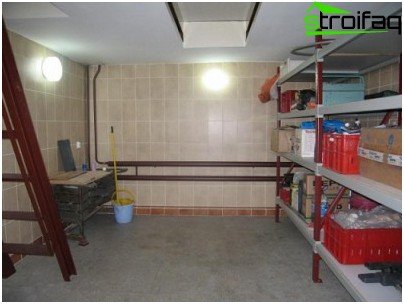
Garage water heating is advisable if the garage is an extension or part of the house
Solid fuel options
Garage heating with wood or other types of solid fuel is used when electricity or gas is not available. The main advantage is the cheapness of fuel, home-made stoves of the “potbelly stove” type are often used. Heating with a stove is a tedious process. Frequent lining of firewood, low heat dissipation is required, heating is poorly heated completely (next to the stove it’s hot, a little further cold).
Often used ready-made units “Buleryan”. Such a furnace requires laying dry wood once for 5-12 hours. The disadvantages of the Buleryan installation are its high cost, obligatory insulation of the entire chimney, severe clogging of the chimney if it is improperly insulated, and high fuel consumption.
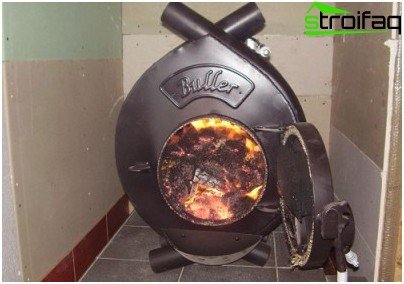
The factory-built Solid Fuel Buller is a reliable but not too cheap option.
You can fold a brick oven. With this method of arranging heating in the garage, good ventilation is extremely important. If the garage is small, then from a fire safety point of view, a wood stove is not the best option. After all, it is necessary to position the stove so that the firebox is outside, and the entire rear part inside. This option involves rebuilding the wall in order to install the furnace, and in order to remove the pipe, rebuilding the roof is required.
The main disadvantage of stove heating is the possibility of fire, as well as penetration of furnace gases into the garage.
Electric garage heating
This is the easiest way to heat the garage, installing electric heaters is much easier than installing a water heating system, conducting gas or folding the stove. True, for this the garage must be electrified and the wiring must be designed for the necessary load. The electric heating method of the garage can be carried out by stationary and portable heaters. The most important thing is to correctly place the heating appliances in the garage.
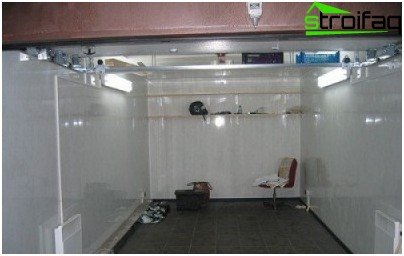
Electric garage heating is the easiest way to organize, but not too profitable to operate because of the cost of electricity
Stationary heaters are installed in specially designed niches and covered with protective shields to prevent them from being accidentally damaged, including by a car upon unsuccessful entry. Electric heaters should be installed strictly observing safety requirements, while in the garage it is forbidden to store fuel and lubricants, the car must be in good working order. When installing portable heaters, you must remember that their use is possible only under the supervision of a person, you can not leave such devices turned on at night.
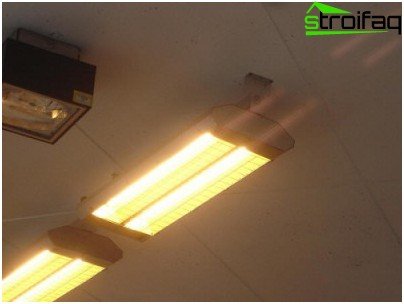
Electric infrared heater
One type of electric heating is infrared heaters. Due to the high temperature of the heater, their use is possible at a garage height of at least 2.5 m, in addition, forced ventilation is necessary, since in the garage it is impossible to completely eliminate the evaporation of fuel. Direct thermal effects on the car paint should be avoided. Install infrared heaters above the entrance to the garage, while arranging a thermal curtain.
The advantage of electric garage heating is the possibility of periodic use, for example, for the duration of repair work, the disadvantage is the high cost of electricity.
Garage gas heating
Compared to other heat sources, natural gas is the cheapest fuel. But for the implementation of gas heating in the garage, you need to attract a specialized specialist, it is important to use only factory heating equipment. The room must meet the requirements of sanitary standards (ceiling height of at least 2 m, the presence of smoke and ventilation ducts). Most private garages do not comply with existing standards, due to the small area of the room. Gasification of an object is a very troublesome and expensive affair, it is associated with paperwork for the development of project documentation and the issuance of technical conditions.
It is convenient to use a convector for gas heating of the garage, the gas in it is burned in a closed chamber, the penetration of carbon monoxide into the room in this case is completely excluded. To install a gas convector, you do not need to build a chimney through the roof, you only need a hole in the wall to supply air and exhaust combustion products. Installation and commissioning of equipment is carried out only by gas workers.
The advantage of this method of heating is the automation of fuel intake, the possibility of round-the-clock heating, high efficiency and reliability of heating equipment. Main gas is not always available for bringing to the garage, this fact can be called the main disadvantage of this method.
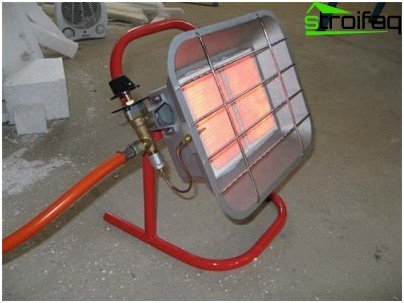
Infrared gas liquefied gas heater
Perhaps heating the garage with liquefied gas. For this, special heat guns, convectors, ceramic furnaces, gas panels are used. This option for arranging heating in the garage is considered one of the most affordable and simple. The ceramic furnace is compact, it does not require a chimney, it is advisable to place the cylinder with liquefied gas outside, in a special box. All you need to do is drill a hole in the wall for the hose.
How to heat with used oil
During the operation of the vehicle, a periodic oil change is necessary. Accumulated mining can be used for heating the garage. The used oil is pre-cleaned and processed in special heat installations. The advantage of this method in the rational use of recyclables.
A lack of instability (heating equipment often fails due to heterogeneous fuel composition).
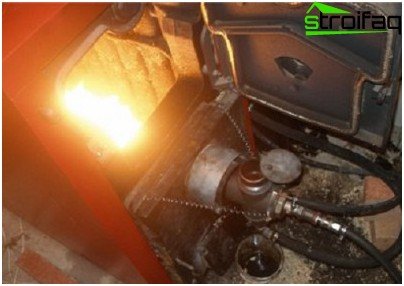
Waste oil incinerator
The use of portable devices
The use of portable electric heat guns, direct and indirect heat generators, and various kinds of mobile furnaces is widespread. The garage heating system organized by portable heaters cannot be operated around the clock (use is possible only in the presence of a person).
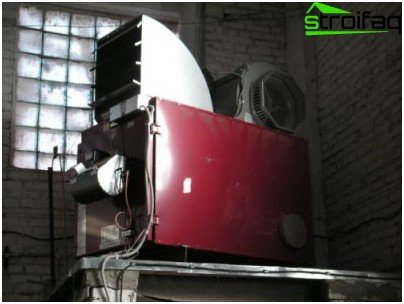
Automatic heat generator
A feature of portable heaters is a low degree of fire safety. Various fan heaters with a liquid heat exchanger are really effective: they quickly warm the air in the garage. But there are certain restrictions on using offline for a long time without human control, which is not very practical.
When choosing an autonomous heating option, remember that a garage is a fire hazardous area, in addition to a car, it often contains flammable materials: fuel supplies, lubricants, car cosmetics, tires for wheels, etc. Therefore, the main requirement for a heating device is fire safety. The next important and mandatory condition is ventilation, with the help of which moisture, various harmful and fire hazardous fumes are removed from the garage, and ventilation is necessary both in a heated and in an unheated garage. The methods and options for autonomous heating of the garage are chosen taking into account the availability of energy, the nature of the heating (permanent or periodic), the size and location of the garage.
As you can see, there are many ways to arrange garage heating. Everyone chooses how to make heating in the garage at their discretion, the main thing is to weigh the pros and cons. The effectiveness of any method in many respects also depends on proper thermal insulation.


